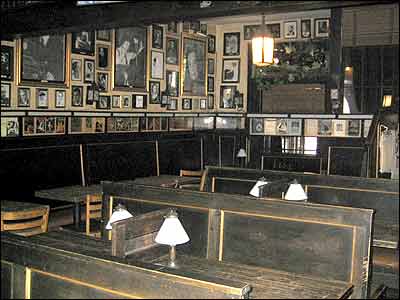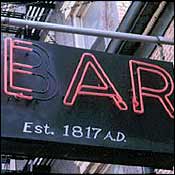
Bridge Café (1794)
Then
Clientele: dock workers, prostitutes, johns
Popular Drinks: rum, “applejack”, strong beer (6% alcohol), Madeira wine
Bar Talk: new-found freedom from Great Britain
Now
Clientele: locals, financial types, politicians, tourists
Popular Drinks: single malt scotch, wine
Bar Talk: new freedom-limiting Patriot Act
When the Brooklyn Bridge first blocked the sun of Water Street in 1883, this bar/restaurant had already been serving the local population for almost a century—in more ways than one: An 1860 NYC census lists 279 Water St. as the home of six Irish prostitutes. The Bridge Café is only a few blocks from the South Street Seaport, but it’s decidedly not a tourist trap. After all, Ed Koch held court here twice a week at his private table during his mayorship, and city politicians still take advantage of its communal but easygoing air to conduct business here over a couple of cold ones. That, and the Bridge Café’s specialties—soft-shell crabs ($15 appetizer/$28 entrée) and whiskey (65 single-malt and small-batch bourbons to choose from, $7.25-$33/glass). For the pence-pinchers, “tastes” of these whiskeys are also available, for roughly one-third the price; beer, wine and mixed drinks start at $5.

Ear Inn (1817)
Then
Clientele: wharf rats, sailors, the unemployed
Popular Drinks: corn whiskey, home-made beer
Bar Talk: “Is the city really going to build a subway?”
Now
Clientele: artists, bikers, professionals
Popular Drink: beer, wine
Bar Talk: “Is the city ever going to build the Second Avenue line?”
Only two decades younger but much funkier than the Bridge Café is the Ear Inn (the blacked-out right side of the “B” in the neon “Bar” sign outside gives this establishment its memorable name). To be accurate, it didn’t start serving drinks until the 1890s, when an Irishman named Tom Cloke bought the place and turned it into a rough-and-tumble watering hole for Spring Street’s longshoremen waiting for ships to dock. Nowadays, you’re more likely to run into an artist waiting for work and bellied up to a $5.50 pint and a Moroccan salad—hummus, tabouli, yogurt, and fruit ($7). The wide-planked floor is so old and worn it feels soft under your feet, and the walls and shelves are completely cluttered with art and tchotchkes. Cozy, warm and comfortable, you can spend countless hours eating and drinking here like those longshoremen did a century and a half ago.
Chumley’s (1830s)
Then
Clientele: neighborhood, literary giants
Popular Drink: whatever was available during Prohibition
Bar Talk: Prohibition infringing on personal liberty
Now
Clientele: neighborhood, Eurotrash, Engine 24/Ladder 5 firefighters, tourists
Popular Drink: beer from Chelsea Piers Brewery, wine
Bar Talk: No-smoking laws infringing on personal liberty
The space itself is about 175 years old, but Chumley’s is known best for its glorious days as a speakeasy. (And if alcohol is ever illegalized again, this establishment is still equipped to deal with it.) There’s no sign outside and you must walk through a curtain before you enter the bar. For those inclined to drama, it might feel like you’re entering the stage; for coppers back then, though, it was a good indication they were about to bust up the party, in which case patrons would stampede out the secret back exit, which isn’t such a secret anymore. There’s no other way to describe Chumley’s layout than “really cool.” Multileveled (four different levels to be exact) with booths in the middle, and more booths hidden in the back, it serves just about any purpose a person would need from a bar: You can eat center-stage (portobello burger, $9.50; roast duck, $17, and just about everything in between); mill about in the bar area’s open space and sample the impressive beer selection ($6 pints), or cozy up in a back booth for some romantic time. Better go on a weekday for the latter, though. Weekends can get loud.
McSorley’s (1854)
Then
Clientele: Men only!
Popular Drink: McSorley’s Ale
Bar Talk: Men only!
Now
Clientele: lots of men
Popular Drink: McSorley’s Ale
Bar Talk: Men only!
Famous for opening its doors to women only after legally obliged to do so in 1970, this Village mainstay is the last bastion of the liverwurst sandwich ($3). If gray, pasty meat by-product slathered in mayonnaise isn’t your bag, you can get a cup of soup ($3) or burger ($4.75) and wash it down with light or dark beer. The beers famously come in pairs (i.e., order one, you get two; ask for two, you get four), served in small mugs with almost as much foam in them as the good stuff. The slightest display of confusion will surely betray you as a McSorley’s virgin. Depending on how busy the bar is will determine whether or not you catch some trademark McSorley’s attitude for taking so long to show up. “Be good or be gone” is the motto here, although after 26 or 28 of those frothy mugs of beer, it’s a little hard to heed the signs that say as much.
P.J. Hanley’s (1874)
Then
Clientele: longshoremen
Popular Drink: locally brewed beer
Bar Talk: 1873 Wall Street collapse and subsequent Depression
Now
Clientele: Carroll Gardens locals, sports fans
Popular Drink: martinis, beer, bar drinks
Bar Talk: Skyrocketing NYC real estate market forcing locals out of the neighborhood
Pretty much unknown to those outside the Italian neighborhood of Carroll Gardens, as well as many newcomers to it, P.J. Hanley’s is where locals come to drink, watch the Yankees, and debate about when the meatballs go in the sauce. During the 131 years of its existence, the bar has had only four owners, making it not only one of Brooklyn’s oldest bars, but one of the most genuine “neighborhood bars” in the borough. It’s beloved by regulars for its burgers ($6.75), and by big spenders for its T-bone steaks ($23.95). Guinness pints are cheap for NYC ($4); martinis and mixed drinks start at $7. Important note for those in the armed forces: The first drink is on the house for anyone wearing a military uniform. “If Uncle John [the previous owner and WWII vet] ever saw us charge a serviceman,” says co-owner Deborah Hanley, “he’d turn over in his grave.” As for the rest of us, it’s dollar domestic drafts (8 oz.), all night every night. Not bad at all.
1
Did You Know That…
Bridge Café
When it was built, before massive land-fill projects dramatically expanded the surface area of Lower Manhattan, the East River actually came up to the structure’s foundation.
Ear Inn
Charred and axe-marked timber discovered in the Ear Inn’s attic has led some historians to believe the dwelling was constructed partly out of left-over lumber from the great fire of 1776, which wiped out one-third of the city.
Chumley’s
86 isn’t only a number. To “86” someone traditionally means to eject them from a bar or restaurant. Given Chumley’s address of 86 Barrow St., along with its fame as a speakeasy, some etymologists believe the phrase originated here during Prohibition, as a code to customers warning that cops were snooping around.
McSorley’s
The famous poet e.e. cummings penned a poem entitled “i was sitting in mcsorley’s.” In it, he describes the bar as “snugandevil.”
P.J. Hanley’s
Red Hook-born Al Capone tied the knot a few hundred feet from P.J. Hanley’s, and it’s also known that he met his Irish bride in the basement of a speakeasy on Carroll Street. P.J. Hanley’s (then called Ryan’s) was as hoppin’ a speakeasy as any. Could it be that the Godfather of all Godfathers downed some anisettes within these very walls?